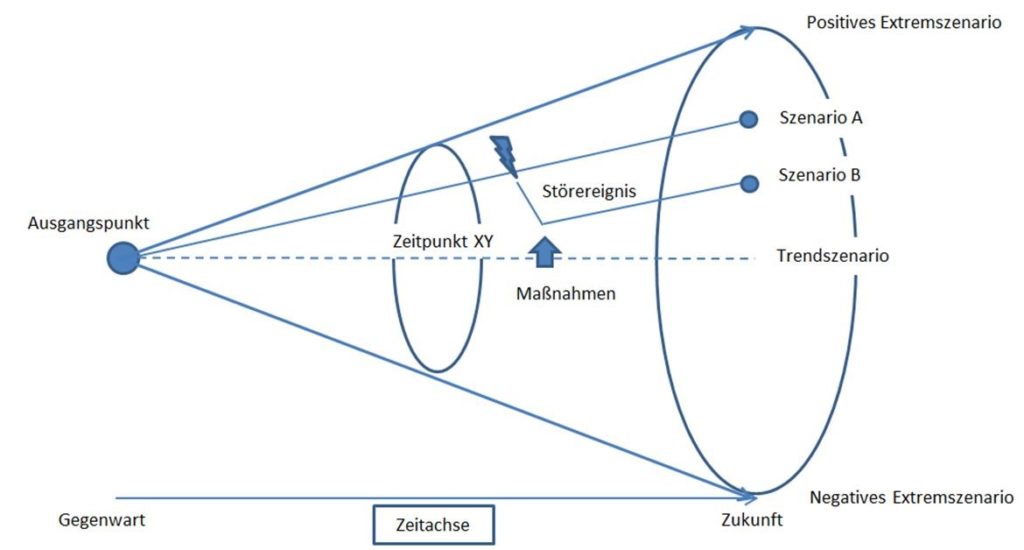In response to Christoph Grissemann’s question in “Welcome Austria” on Tuesday evening: “Will it ever be the same again?” Christoph Steininger, virologist at MedUni Vienna, replied: “… A lot is currently changing, the economy will change, our society will change as well.
While some are in the middle of the crisis management mode, others are already dealing with the post-crisis period. The Zukunftsinstitut, founded by Matthias Horx, has developed four scenarios for a post-corona virus era in cooperation with a wide range of specialists. The scenarios go from a return to a Biedermeier era, to a worldwide re-globalization (back to the nation-states), to a higher resilience of society to cope with crises.
Working with scenarios in the business environment
In addition to crisis management and the measures required to overcome it, a look into the future is needed in order to be able to plan for the long term. To do this, however, we do not use a “glass ball”, but work in a structured manner using the scenario technique. Scenarios are used to describe possible developments in the entire environment relevant to the company. However, they can also be used for limited sub-questions (e.g. to assess location decisions).
Scenarios are plausible representations of several different possible future developments. Assumed sequences of future events are based on the combination of various external influencing factors and driving forces, the future development of which is highly uncertain. Unlike relatively specific forecasts, scenarios encourage people to think about strategic options and alternatives in broader categories.
Procedure
Phase 1: Scenario field determination
Phase 2: Key factor identification
Phase 3: Key factor analysis
Phase 4: Scenario generation
Phase 1: Scenario field determination
In this first work phase, you first define and describe the object of investigation in the context of a task and problem analysis. The result of this phase is a concrete question that your scenario project should answer, including a concrete period of observation.
Phase 2: Key factor identification
In this step, you define the driving forces that are beyond the control of the company. A STEP or PEST analysis can be used for this purpose: This analysis is a model of the external environmental analysis and lists factors that may have an influence on the situation under investigation:
- S ociological factors are values, lifestyle, demographic influences, income distribution, education, population growth and security.
- T echnological factors include research, new products and processes, product lifecycles, government research spending.
- E conomic factors are economic growth, inflation, interest rates, exchange rates, taxation, unemployment, business cycles, availability of resources.
- P olitical factors include competition supervision, legislation, political stability, tax directives, trade barriers, security requirements and subsidies.
In this phase it is helpful to involve as many different experts in the company as possible.
Phase 3: Key factor analysis
For the defined influencing factors, you determine in a next step for possible future characteristics. The scenarios then result from the meaningful combination of these possible values.
You record this mutual influence quantitatively through influence strengths. Here
0 = no effect on the other factor
1 = small effect on the other factor
2 = strong effect on the other factor
3 = very strong effect on the other factor
For this purpose, it is important to keep the number of influencing factors, their specific characteristics and combinations limited. For this purpose, the approaches must be checked for plausibility at every step.
Phase 4: Scenario generation
The scenario funnel according to Albers & Brooks (1999) serves as a visualization of the scenario technique. It shows three scenarios as cornerstones:
- The “best case scenario” as the most favorable future development
- The “worst-case scenario” refers to the most unfavorable course of development.
- The “trend scenario” involves extrapolating the current situation into the future

Along the funnel you describe a positive, a negative, and a probable future picture. Also develop extreme scenarios!
On a time axis, beginning with the present, you describe possible disruptive events and their impact on development. The influencing factors and their previously defined strengths of influence provide a helpful basis for this.
Based on the disturbance events, you then develop measures with regard to the relevant influencing factors. Questions here are:
- How can a desired development be strengthened?
- How can an undesirable development be prevented?
Especially
in a time in which the future can be “predicted” less and less
accurately, working with scenarios is a good way to remain capable of acting
beyond the “crisis management mode” and to “think outside the box”
by describing alternative future situations and developing paths that can lead
there.
You have questions or need support?
Contact us and we will find the right format to support you as a manager or personnel developer whose managers are currently facing quite a few challenges.
Our office manager, Margit Darnhofer, will be happy to help you with specific questions.


Recent Comments